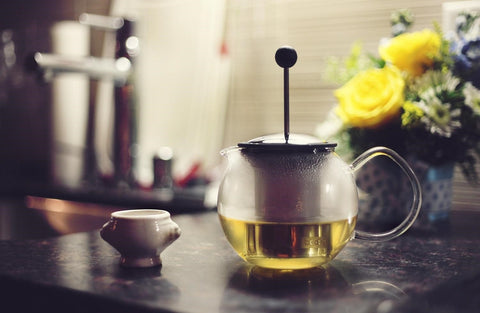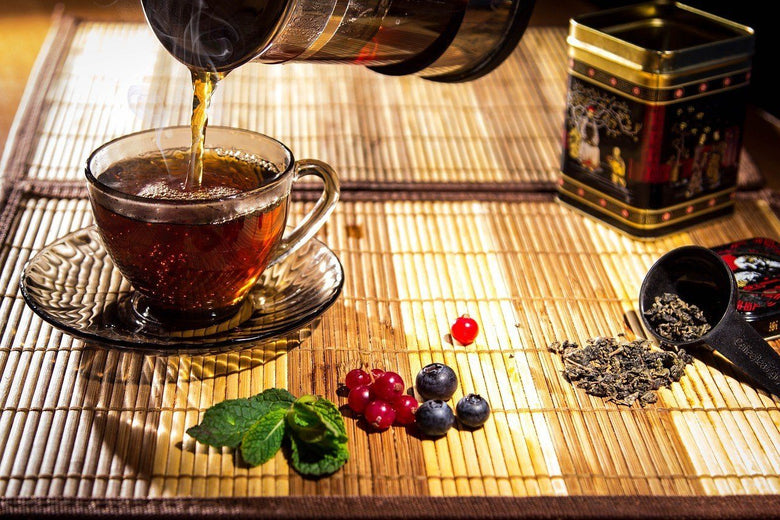Yes, I realize we’re a coffee company and that this article is about tea, but loose leaf tea is something worth exploring.
Much like coffee, it’s an agricultural product that can be quite fascinating. However, there are some key things that make it different.
- There’s much more flavor diversity among tea types compared to coffee
- Tea history spans thousands of years - coffee’s only several hundred years
The world of tea is rich, diverse, and fascinating, and you can easily explore it with your french press. Here’s everything you need to know to give specialty-grade loose leaf tea a good shot.
Tea Types 101: How We Categorize Tea
Let’s get something straight: tea is the leaves of the camellia sinensis plant.
That’s all. Nothing else is true tea.
Chamomile, pine needles, hibiscus, and other non-camellia sinensis ingredients are what we call herbal tisanes (or herbal teas, according to normal people). But they’re not actual tea.
Read: Metal VS Glass: Which Type Of French Press Should You Buy?
So, even though all real tea comes from the same plant, there’s TONs of diversity. The following tea types taste very different, are made differently at the farm, and have different caffeine levels.
Let me break it down for you.
Black Tea
Black tea is what most Americans consider to be “normal” tea. It’s not actually the “normal” tea, but it is the most common tea type in the western world, so I usually let it slide.
Black tea leaves are fully-oxidized during the processing stage. This causes them to have more caffeine, and less antioxidants than other types, though they’re still a great source of antioxidants.
Black teas tend to feature deeper, darker flavors, such as dark chocolate, spice, earthiness, citrus, and malt.
Water: 195-205 degrees Fahrenheit
Steep: 3-5 Minutes
Caffeine: 20-80 mg
Read: The Incredible Journey Of The Coffee Bean (Seed To Cup)
Oolong Tea
This tea type is a very large category, comprising of teas oxidized 8-90%. Yeah, lots of room in this category for flavor diversity!
Teas on the lighter end of oxidation are called “light oolongs”. These teas feature flavors closer to green tea with floral, citrus, and nutty notes. They can be very sweet and pleasant.
Teas on the upper end, called “dark oolongs”, tend to feature flavors closer to black tea with earthy, fruity, and woody notes. They’re also complex and pleasant, but often not as sweet.
Water: 180-195 degrees Fahrenheit
Steep: 2-4 Minutes
Caffeine: 15-60 mg
Green Tea
Green tea is growing in popularity in the Western world, but it’s the #1 type in the East. In China, green tea is the “normal” tea.
These leaves are less oxidized, between 2-8%, and are more delicate. They need a lower water temperature and shorter steeping time to bring out best flavors without over extracting. Those flavors include herbs, flowers, nuts, earth, and citrus
Water: 170-180 degrees Fahrenheit
Steep: 2-3 Minutes
Caffeine: 15-40 mg
Read: Why Gratitude Makes You Happy

White Tea
White tea leaves are only 0-2% oxidized. They’re as close to freshly picked leaves as we get in America (unless you live on a tea farm in Hawaii or Florida). They’re even more delicate, requiring very low water temperatures and short steeping times.
The flavor profile is also delicate, featuring gentle notes of flowers, herbs, and some light fruits such as peach.
Water: 160-175 degrees Fahrenheit
Steep: 2-3 Minutes
Caffeine: 10-30 mg
Herbal Tea
Herbal teas aren’t really teas since they don’t come from the camellia sinensis plant, but you can still brew them in your french press. This could literally be anything - herbs, barks, flowers, leaves.
Most steep well with something like this:
Water: 195-205 degrees Fahrenheit
Steep: 5-10 Minutes
Caffeine: Depends on the ingredient steeped
Find the tea type that best suits your flavor and caffeine preferences. You’ll find there’s a lot of diversity within the categories, so try out several teas of each type to get a good idea of the flavor possibilities.
Read: Why Fresh Coffee Is The Best Coffee
Now, let’s move onto how to brew them in your french press.
Getting Started With Tea Steeping In Your French Press
Before you even get close to mixing water and leaves in your press, clean that french press thoroughly. Seriously, don’t skip this step!
Wipe every inch of it with a clean paper towel afterwards to get those most stubborn coffee oils. Trust me, you DO NOT want aromatic coffee oils to taint your tea’s flavor. So, if you can smell coffee in the press, keep cleaning.
Also, it’s very important for great tea that you stick as close to the temp suggestions as possible. If you pour boiling water on green tea, you’re going to end up with a bitter mess, and your perception of green tea will be way off.
I strongly suggest using a thermometer to monitor your water temperature. Bonus points if you have a variable temperature kettle.
Read: The Perfect Water Temperature For Coffee Brewing
Generally, I suggest using about 2.5g of loose leaf tea leaves per 8 ounces of water. This is a balanced amount that gives off flavor without being overpowering.
2.5g usually equals 1-2 teaspoons, but I strongly suggest measuring by grams instead since all tea leaves are different sizes, shapes, and weights.
Teaspoons just aren’t that consistent. 2 teaspoons of a rolled oolong may weigh 6g, but 2 tsp of a white tea may be 1g. Measuring by grams gives you consistency and precision every time.
Alright, let’s get to the step-by-step guide!
Step By Step Tea Brewing
Start warming your water on the stove. Watch the water temp and pull it off the heat once it gets to 180 degrees.
Weigh 2.5g of your favorite tea. For this example, we’ll use green tea.
Pour the leaves in the french press, then pour in 8 ounces of hot water. Start a timer for 2 minutes.
When time’s up, pour out the liquid tea through a strainer and enjoy.
For subsequent steeps, add 30 seconds each time.

What about iced tea?
Simply double the tea leaves or half the amount of water. You’re going for tea that’s x2 as strong so that you can still taste it when it’s diluted by ice. When the brewing’s finished, pour the extra-strong tea over ice.
Hot or iced, tea brewing is easy!
Read: Iced Coffee VS Cold Brew: What's The Difference?
Troubleshooting Your Tea
If your tea isn’t quite right, there are a few things to try
If your tea is not the right strength, adding or taking away tea leaves is the easiest solution. You can also add or take away some steeping time, as well as increase or decrease the water temperature slightly.
If your tea is too bitter, it’s likely that you over extracted from the leaves. Try either reducing the steeping time or using a lower water temperature.
If nothing seems to make the tea taste good to you - it’s okay. Some teas may just not jive with your taste buds.
---
The world of tea is rich with interesting flavors. Everything from sweet fruits to dark chocolates to smooth flowers. Even if you’re a die-hard coffee fan, tea is worth exploring.
To begin your tea journey, I suggest buying specialty quality tea leaves from these sources:
And, just like with coffee, fresh is best!
Also, get yourself a french press if you don’t already have one, of course!
Happy tea brewing!


